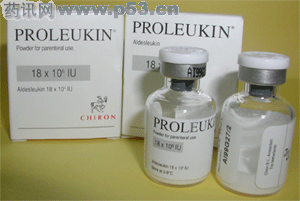|
【中文别名】 阿地白介素、阿地流津、白介素-2、重组人白介素-2 、普留净 对本品或本品制剂中任何组分发生过敏者、肺功能试验严重异常者、同种器官移植者禁用。 Proleukin® (aldesleukin) is indicated for the treatment of adults with metastatic renal cell carcinoma or metastatic melanoma. IMPORTANT Safety Information
Therapy with Proleukin® (aldesleukin) should be restricted to patients with normal cardiac and pulmonary functions as defined by thallium stress testing and formal pulmonary function testing. Extreme caution should be used in patients with a normal thallium stress test and a normal pulmonary function test who have a history of cardiac or pulmonary disease. Proleukin should be administered in a hospital setting under the supervision of a qualified physician experienced in the use of anticancer agents. An intensive care facility and specialists skilled in cardiopulmonary or intensive care medicine must be available. Proleukin treatment is associated with impaired neutrophil function (reduced chemotaxis) and with an increased risk of disseminated infection, including sepsis and bacterial endocarditis. Consequently, preexisting bacterial infections should be adequately treated prior to initiation of Proleukin therapy. Patients with indwelling central lines are particularly at risk for infection with gram positive microorganisms. Antibiotic prophylaxis with oxacillin, nafcillin, ciprofloxacin, or vancomycin has been associated with a reduced incidence of staphylococcal infections. In clinical studies, the following side effects whose severity was life threatening were seen in >1% of 525 patients (255 with metastatic renal cell cancer and 270 with metastatic melanoma) treated with Proleukin were: decreased urine (6%), stopping of all urine (5%), low blood pressure (3%), breathing problems (3%), abnormal blood test (high bilirubin) for how the liver works (2%), coma (2%), diarrhea (2%), too many acid chemicals in the blood (1%), sudden kidney failure (1%), stopping breathing (1%), heart problems (1%), clotting problems (1%), confusion (1%), abnormal blood test (high creatinine) for how the kidney works (1%), shortness of breath (1%), fever (1%), heart attack (1%), infection (1%), severe mental illness (1%), infection in the blood (1%), abnormal blood test (high SGOT) for how the liver works (1%), severe sleepiness (1%), fast heartbeat (2%), low blood platelet count increasing the chance of bleeding (1%), and vomiting (1%). From the same studies, the most common side effects of any severity were seen in >30% of 525 patients (255 with metastatic renal cell cancer and 270 with metastatic melanoma) treated with Proleukin were: low blood pressure (71%), diarrhea (67%), decreased urine (63%), chills (52%), vomiting (50%), shortness of breath (43%), rash (42%), abnormal blood test (high bilirubin) for how the liver works (40%), low blood platelet count increasing the chance of bleeding (37%), nausea (35%), confusion (34%), and abnormal blood test (high creatinine) for how the kidney works (33%). In patients receiving Proleukin in these studies (255 with metastatic renal cell carcinoma and 270 with metastatic melanoma), 4% (11/255) of patients with metastatic renal cell cancer and 2% (6/270) of patients with metastatic melanoma died from treatment-related side effects of Proleukin. |
普留净注射剂Proleukin(r)(Aldesleukin阿地白介素注射液) rhIL-2简介:
【中文别名】 阿地白介素、阿地流津、白介素-2、重组人白介素-2 、普留净 【英文别名】Proleukin 、Aldesleukin 【生产企业】: 【药品类别】其它抗肿瘤药 【药理药动】本品的生物活性 ... 责任编辑:admin
|
最新文章更多
推荐文章更多
热点文章更多 |



